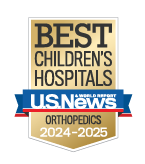Clubfoot
My ultrasound showed a clubfoot...what does that mean?
A clubfoot is a congenital (present at birth) foot deformity. The foot and ankle did not develop normally in utero. In most cases, the foot appears to be pointing downwards and inwards. Your doctor can often detect clubfoot by ultrasound in the second trimester.
Clubfoot is the most common foot deformity present at birth, occurring in approximately 1 in every 1,000 births. Boys are twice as likely than girls to be born with a clubfoot and one or both feet may be affected. Most children born with clubfeet are otherwise healthy, but clubfeet can occur with other birth defects.
At Children's Mercy, our highly experienced specialists in the Fetal Health Center can conduct a detailed fetal ultrasound. Clubfoot does not require that you deliver your baby at Children’s Mercy, nor does it require any different care in the delivery room.
What causes a clubfoot?
The cause is unknown. There is increased risk of clubfoot with a family history of clubfoot. Clubfoot is also more common in children with a neuromuscular disorder, such as spina bifida, arthrogryposis or amniotic band syndrome.
What should I do when my child is born?
Call the Orthopedic Clinic at (816) 234-3075 when your child is born to schedule an appointment. We will make the diagnosis with a complete physical examination. Sometimes a prenatal test can show an infant has clubfoot when it is actually a positional foot deformity, meaning the foot is genetically normal and was just "scrunched" in utero. These feet will improve most often with no treatment.
Treatment for clubfoot
Treatment for clubfoot usually involves a series of casts called the Ponseti technique to gradually reposition the foot. About 90% of babies will also require a surgical procedure to lengthen the Achilles tendon in their heel. After the tendon heals, your child wears a brace to prevent the clubfoot from recurring. The brace is typically worn full-time for three months, followed by night and naptime wear until they are 3 or 4 years old. Without bracing, 90% of clubfeet will recur.
A general timeline for clubfoot treatment looks like this, but may need to be individualized based on each child:
- When your baby is 3 weeks old – First appointment at the Orthopedic Clinic
- When your baby is 3 to 9 weeks old – Weekly serial castings for approximately 5 to 6 weeks
- When your baby is 8 to 10 weeks old – Achilles Tenotomy/heel cord lengthening procedure, if needed
- When your baby is 11 to 13 weeks old – Additional casting for 3 weeks, if needed, after surgery
- When your baby is 3 to 6 months old – Baby wears a brace for 20-23 hours a day
- When your child is 6 months to 4 years old – Child continues to wear the brace for naps and at night as directed by your doctor
The goal of Ponseti treatment is for your child to have a functional, pain-free foot that is flat on the ground and has good mobility.

Want a second opinion?
If you’ve recently received a diagnosis or would like a second opinion, experience matters. We're happy to share our expertise with you. Call (816) 855-1800 to make an appointment with our team.
Follow-up care with our top-ranked team
As your child grows, we will continue to see them as needed in the Orthopedic Clinic for follow-up care.
Learn more about our nationally-ranked Orthopedic team at Children’s Mercy.
